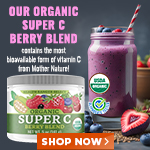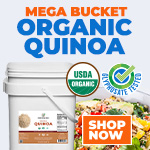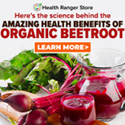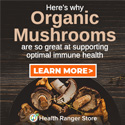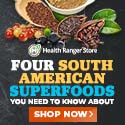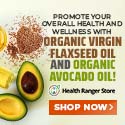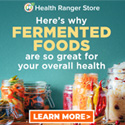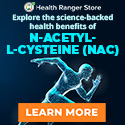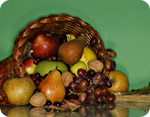
New "Juice Feasting" Emerging as Phytonutrient-Rich Disease-Fighting Nutritional System
 Tuesday, December 11, 2007 Tuesday, December 11, 2007by Mike Adams, the Health Ranger Editor of NaturalNews.com (See all articles...) Tags: Juice Feasting, health news, Natural News |
- Newly released JFK files reveal Pentagon's role in creating Lyme disease and covid in the same lab
- Dr. Suzanne Humphries makes bombshell appearance on Joe Rogan podcast, exposing vaccine industry deception back to POLIOMYELITIS
- L.A.'s rebuilding nightmare: Only 4 permits issued after fire destroys 6,000 homes
- Discovery of vast underground city beneath Giza pyramids challenges human history
- Black cumin seed oil emerges as a powerful ally against breast cancer and chronic inflammation
- “Independent” anti-Russia outlet MEDUZA faces COLLAPSE as US funding dries up
- Catastrophic 7.7 earthquake devastates Myanmar and Thailand; death toll could reach 100,000
- The hidden battle in your glass: How A1 and A2 milk could shape your health
- AI breakthrough slashes celiac disease diagnosis time from months to minutes
- BPA: The hidden hormone disruptor sabotaging your health - and how to fight back
- Sugar-free deception: Artificial sweeteners hijack hunger signals, fuel obesity epidemic, study warns
- Europe braces for WAR as EU urges citizens to STOCKPILE FOOD, in latest provocations with Russia
- Putin vows to 'finish off' Ukraine, accuses West of prolonging the war
- Thomas Massie’s Dual Loyalty Disclosure Act aims to restore American sovereignty by cracking down on foreign influence in Congress
- Aluminum pollution: A silent threat to human health
- Tesla owners under siege: Road rage, vandalism and political backlash fuel fear among drivers nationwide
- Chaos in Amsterdam: Five injured in broad daylight knife attack near Dam Square
- "Feel G.O.O.D. Gut Health Program" on BrightU: Dr. Basima Williams introduces the Feel-Good Plate Method
- Newly released JFK files reveal Pentagon's role in creating Lyme disease and covid in the same lab
- Analysis: The coming economic collapse, a mass uprising and Trump's three secret weapons to halt the growing revolt
- Festive flavors: The sweet history, nutritional profile and health benefits of pecan pie
- Elon Musk: Aliens could be here on Earth RIGHT NOW
- Trump reverses course on Gaza plan, says “nobody is expelling Palestinians”
- Big Pharma's $8 Billion bribery scheme exposed: how doctors are pushed to prescribe junk science, not heal
- Boys are back in town: Trump’s patriotic alpha crew takes the wheel while toxic females ride in the backseat
- Reclaim your health: How midlife exercise reverses years of inactivity
- A lack of integrity in Academia: Harvard professor found GUILTY of fraudulent research to promote CRT theory
- Survival 101: Effective EMF blocking techniques
- EPA advisor admits the agency is funneling billions to climate groups ahead of Trump’s return to White House
- Dr. Mike Yeadon releases 15-minute testimony - WATCH - about genocidal intent of COVID “vaccines”
- 5 Simple steps to boost your brainpower: How to strengthen executive function in a distracted world
- Florida takes a stand: DeSantis proposes permanent ban on mRNA vaccine mandates
- Sugarcane extract superior to cholesterol-lowering drugs?
- Mike Adams Sermon 66: God will DESTROY ISRAEL for its wickedness
- Pilots report mysterious lights 'moving at extreme speeds' across Oregon skies
- Space war brewing? Russia threatens to destroy Starlink satellites
- EPA advisor admits the agency is funneling billions to climate groups ahead of Trump’s return to White House
- California's social media censorship law struck down: A victory for free speech or a threat to online safety?
- The Health Ranger releases “Vaccine Zombie” song and music video, using AI-animated zombies for the music video
- Dr. Mike Yeadon releases 15-minute testimony - WATCH - about genocidal intent of COVID “vaccines”
- The pandemic as a tool for INDOCTRINATION: Understanding “The Indoctrinated Brain” by Dr. Michael Nehls
- Newly released JFK files reveal Pentagon's role in creating Lyme disease and covid in the same lab
- Florida takes a stand: DeSantis proposes permanent ban on mRNA vaccine mandates
- Mike Adams releases country western hit single: Goin’ Back in Time is Comin’ Home
- Mike Adams releases music poetry sensation: A Child of God
- “Why we influenced the 2020 elections”: Facebook files reveal the coordinated effort to bury the Hunter Biden laptop story
- Unpacking the Lies That We’ve Been Fed – new song and music video released by Mike Adams, the Health Ranger
- RFK Jr. clears key hurdle: Sen. Susan Collins backs controversial HHS nominee, signaling a new era for health policy
- Mike Adams releases new song and music video: Nothing More Disgusting Than a Globalist
- Michigan sheriff announces criminal investigation into 2020 election crimes, Dominion Voting Systems
- Israeli soldiers accused of even more torture and abuse in the West Bank
- Migrants are taking advantage of recent hurricanes to scam residents and loot their homes
- House Intelligence Committee calls for the ARREST and PROSECUTION of Dr. Anthony Fauci
- Rep. Nancy Mace introduces bill to ban biological males from female facilities on federal property
- Red Cross issues warning to stop blood plasma donations from vaccinated people
- Scientists confirm: GENIUS brain function can be spontaneously unleashed in humans without any apparent cause
- EPA advisor admits the agency is funneling billions to climate groups ahead of Trump’s return to White House
- HYSSOP: What research reveals about the health benefits of this ancient holy herb
- Two containers with completed ballots fall out of truck in Florida
- Fully vaccinated about to see “tsunami” of illness and death, warns virologist
- Global leaders unite to clamp down on “misinformation” with UN-backed Cascais Declaration
- BREAKING: 2025 NDAA authorizes mandatory military draft of WOMEN across America… as Pentagon pursues global NUCLEAR war with both Russia and China at the same time
- Michael Yon warns of a ZIONIST TAKEOVER in Trump’s second administration
- BOMBSHELL: DNA testing kits are a SCAM to develop ethnic-specific bioweapons
- Ozempic and Wegovy weight loss drugs are injectable LIZARD VENOM PEPTIDES that may unleash a devastating wave of organ failure… side effects align with symptoms of SNAKE BITES
- Israeli soldiers accused of even more torture and abuse in the West Bank
- These 13 countries just signed an agreement to engineer a global FAMINE by destroying food supply
- NASA admits that climate change occurs because of changes in Earth’s solar orbit, and NOT because of SUVs and fossil fuels
- RFK Jr. clears key hurdle: Sen. Susan Collins backs controversial HHS nominee, signaling a new era for health policy
- Sermon 30: How Jesus reveals Caesar’s FAKE CURRENCY and FALSE AUTHORITY
- Coriander seeds: Ancient medicine backed by modern science
- Arizona officials claim Maricopa County needs 10-13 days to tabulate results of the election
I believe it's not only a cure for many cancers, it's also a documented, proven cure for type-2 diabetes (a disease the American Diabetes Association laughingly claims "has no cure"). It can also completely reverse heart disease, depression, most mood disorders, liver disease, kidney stones, chronic inflammation, arthritis, gout, urinary tract infections, asthma and numerous other health conditions.
What could this amazing nutritional medicine be? I'll give you a hint: It's not one single nutrient, food or superfood. In fact, it's a combination of literally thousands of known phytochemicals (and probably thousands more that have yet to be discovered). If you're stuck with a troubling health condition and don't know how to solve it, this may be just the nutritional answer you've been looking for.
I'll give you some other clues about what this is:
• It's not a product you can buy. No supplement company makes it. In fact, it is impossible to manufacture in a factory because it has a shelf life of only a day or so.
• You make it yourself in your kitchen using simple ingredients found at any grocery store.
• The health benefits of its nutritional constituents are backed by literally thousands of scientific studies.
• It's based entirely on medicine from Mother Nature and contains absolutely nothing made by Man.
• It's not available by prescription. The FDA has no clue this even exists.
• It has absolutely no negative side effects. No one has ever been harmed or killed by using this natural source of medicine.
• It halts cancer better than chemotherapy, stabilizes blood sugar (and reverses diabetes) better than diabetes drugs, reverses heart disease better than cardiovascular drugs, and stabilizes moods and mental function better than antidepressants.
• It creates radiant skin, happy moods, clean breath and loads of natural energy.
• It's something you can start right now and continue for a life time.
• It's incredibly delicious. Once you try this, you'll want more.
• It's affordable! It's actually no more expensive than the processed foods it replaces.
What is it? Allow me to introduce David Rain's Juice Feasting.
David Rain's Juice Feasting www.JuiceFeasting.com
You may have heard of "Juice Fasting" or "Juicing," but this is something quite different. It's called "Juice Feasting" and it involves drinking large quantities of plant-based juices that you make yourself, right in your own kitchen, using nothing more than a blender and a nut milk bag. (You don't need a juicer to do this.)Juice Feasting is a nutritional protocol where you replace most or all of your meals with freshly-made vegetable and fruit juices. So instead of eating cooked food, processed food or "instant" foods for breakfast, lunch and dinner, you drink delicious raw juices throughout the day. There's no deprivation, no fasting and no starvation. You can drink unlimited quantities of all the fresh, delicious juice you want!
This provides every nutritional element needed for human consumption, including plenty of protein. (Raw vegetables are loaded with protein. It's only when you cook them that the protein is destroyed.) Plus, it delivers literally thousands of disease reversing phytonutrients, including many that are well documented to reverse cancers, diabetes, heart disease, obesity, arthritis and many other conditions.
On top of this, you can of course continue to consume superfood supplements or high-grade nutritional supplements targeted to your specific health needs. Juice Feasting doesn't replace your supplements; it replaces your unhealthy cooked food with nature's most delicious, drinkable food!
You can learn more about how Juice Feasting works by visiting David Rain's website, www.JuiceFeasting.com where you'll find an enormous amount of information about how Juice Feasting works, how to do it, and how to follow the 92-day timeline for a complete Juice Feast.
David and I have also recorded a six-CD audio program entitled The Secret of Juice Feasting that you can find at http://www.truthpublishing.com/product_p/cd-cat21485.htm
David's recipe on Juice Feasting is the product of nutritional research and idea evolution spanning many decades and involving numerous health pioneers. John Rose is considered one of the important creators of Juice Feasting concepts, and he has done a tremendous amount of work in developing and promoting Juice Feasting ideas. Dr. Gabriel Cousens (www.TreeofLife.nu) has also been involved in a similar protocol: Juice Fasting (not to be confused with Feasting), which involves a nutritional detox (cleansing) experience based on drinking low-glycemic vegetable juices on a limited basis. A fantastic new documentary is coming out soon, by the way, called Raw For 30 Days which features amazing health success stories of people literally reversing serious chronic disease at the Tree of Life Rejuvenation Center in Arizona by following a Juice Fasting protocol.
You can view the trailer for Raw For 30 Days on YouTube: http://www.youtube.com/watch?v=ynXGA6fCEgU
NewsTarget will keep you posted on the final release date for this film.
What's new and unique about Juice Feasting
Getting back to Juice Feasting, the main differences between Juice Feasting and juice fasting or juicing are:• There's no limit to your intake. You can drink as much juice as you want with Juice Feasting.
• You don't need a juicing machine. You can do it all with a blender and a nut milk bag.
• It tastes great! You can modify the recipe to make it as delicious as you want. (All with 100% natural vegetables and fruits.)
• You don't need to go to a juicing center or clinic to do this. You can do it from your own kitchen, safely, affordably and successfully.
I've personally found Juice Feasting to be nothing less than life changing. Once I tried this for three days, I was hooked. I've now been on a modified Juice Feast ever since I met David Rain. It has become my new, healthy lifestyle.
I'm drinking five quarts of juice a day, which means I'm drinking thousands of phytonutrients from about five pounds of fresh produce every single day. That means I'm bathing my body's cells in the most powerful disease reversing medicine in the universe. While the USDA recommends that Americans get 3 servings a day of vegetables (and that can include dead, cooked or pasteurized vegetables), I'm getting an incredible TEN servings a day (at least!) of RAW, fresh vegetables. And on top of that, I'm getting at least FIVE servings a day of raw, fresh berries and disease-reversing fruits.
Presently, less than half the U.S. population consumes even the bare minimum three servings of vegetables each day (source: USDA). And most of that is made of cooked, pasteurized or otherwise destroyed veggies. Juice Feasting, in contrast, allows you to greatly exceed the minimum daily consumption guidelines, achieving an intake of 300% more healing phytonutrients than the majority of Americans.
Why is this important? Because a tidal wave of new research published in the last three years is pointing to the astonishing reality that plant medicines prevent, reverse and CURE chronic degenerative disease. Just last week, the American Association for Cancer Research published astonishing research on the anti-cancer effects of eating RAW cruciferous vegetables. The research reveals something truly astonishing: That a mere 3 servings of raw cruciferous vegetables a month slashes bladder cancer risk by 73 percent in non-smokers. That's just three servings in a whole month. Imagine the anti-cancer effects derived from drinking a small amount of cruciferous vegetables every single day! (And it tastes great, believe me, because you're using such a small amount of cruciferous veggies compared to all the other ingredients.)
Still skeptical? Read the press releases yourself:
Diet and Cancer Prevention: New Evidence for the Protective Effects of Fruits and Veggies
(December 6, 2007)
http://www.aacr.org/home/public--media/news-releases.aspx?d=945
It says:
• Black raspberry gel halts oral cancers
• Broccoli sprouts block urinary cancer
• Raw cruciferous vegetables drastically lower bladder cancer risk
Chemoprevention, Naturally: Findings on Plant-derived Cancer Medicines
(December 6, 2007)
http://www.aacr.org/home/public--media/news-releases.aspx?d=937
It says:
• Blask raspberry gel (again) halts oral tumors
• Australian-made "Blueberry Punch" drink halts prostate cancer tumors
• Green tea prevents colorectal tumors
Every open-minded doctor who has seen this new research is just astonished at the findings. Even the best pharmaceuticals in the world don't come close to the disease prevention and reversing capabilities of the natural medicines found in vegetables, berries, fruits and herbs. You're witnessing a whole new movement in complementary medicine. Even conventional doctors are starting to take notice. They are increasingly getting behind plant-based medicines and even suggesting their patients start changing their dietary habits to eat these miraculous healing foods.
The USDA is starting to catch up on nutritional science, too
Still skeptical that plant medicines are the future of safe, effective medicine? Even the USDA has some intelligent things to say about nutrition these days (I know, don't be so shocked!). Even though the following document is nearly two years old, it still offers some eye-opening information about the role of plants in preventing and reversing degenerative disease:This is from the USDA's own Agricultural Research Service (ARS): http://www.ars.usda.gov/Aboutus/docs.htm?docid=4142
(Note, in case they move the page, I've included the full text at the bottom of this article.)
So what is modern medicine finally discovering? What are we learning in all this? We are learning that natural botanical medicine is all the medicine you need to prevent every major disease now ravaging modern society.
Plant-based medicines are the answer to diabetes, obesity, cancer, osteoporosis, heart disease, kidney stones, depression and psychosis, behavioral disorders, liver disease, kidney disease, urinary tract infections, skin problems, bad breath, body odor, Alzheimer's, eye health, longevity, colorectal cancer, Crohn's Disease, asthma and too many other health conditions to name. Once you start drinking massive quantities of plant medicines on a daily basis, your so-called "diseases" simply start to vanish.
Within weeks, the symptoms of many diseases start to disappear. Within a few months, some are gone entirely, never to return. People are getting off insulin, diabetes drugs, statin drugs, antidepressant drugs and all kinds of other drugs by switching to plant-based medicines. Juice Feasting is the best way I know of to ingest the highest density of plant-based medicines in their raw, natural, unprocessed form. And that's why I've adopted Juice Feasting as the foundation of my own diet.
Juice Feasting has become the most enjoyable and beneficial diet I've ever adopted. On it, I've eliminated the chronic back inflammation that plagued me after intense workouts at the gym, and now I'm working out like I did in my twenties. I'm pushing more weight in the gym, I have incredible cardiovascular endurance, and my coordination and balance is just outstanding. (I've been pulling one-handed handstands on the workout floor on a regular basis.) I'm 38 years old. People tell me I work out like I'm 25. This tells me quite clearly that the Juice Feasting diet is providing me with plenty of protein. That's no surprise, since the raw spinach and other vegetables I'm juicing are very high in protein in their raw, uncooked state. (I'm also adding spirulina and other green superfoods to my juice, so I'm getting additional high-density nutrients that way.)
I've dropped body fat and become more fit and lean. I've also boosted my cognitive function and memory. It has helped my Spanish lessons tremendously, and I've never been more productive in terms of content creation, reading and research projects.
People often ask me, "Mike, how do you get so much done?" The new answer to that question is simple: Juice Feasting!
Again, check out all the details at www.JuiceFeasting.com
I earn nothing from that website. The only thing I have for sale is the Secrets of Juice Feasting audio CD set that I recorded with David Rain. It's a great course that offers step-by-step guidance for Juice Feasting, along with printed reference guides.
Immediate benefits, lifelong rewards
I've truly never seen anything with this great of an immediate impact on my health. I've taken lots of nutritional supplements, and I continue to do so, but rarely have I experienced such noticeable health benefits. It's actually difficult to experience noticeable benefits from supplements when you're already on a healthy diet, and I've been eating in a very healthy way for years. But what I learned recently is that Juice Feasting was a step up from my existing healthy diet. It has allowed me to take my personal health to the next level, and now my life is enormously more enjoyable because of it.It's also a whole lot simpler. Eating is really, really simple. I eat one cooked meal a day -- usually a baked sweet potato and some raw nuts. (I love the raw cashews from www.TransitionNutrition.com - they're the best I've ever tasted!)
I don't eat anything for breakfast or dinner other than the delicious juices I make once a day. It's the first thing I reach for in the morning, and the last sip I take before going to bed. Juice Feasting has given me more time, better health, greatly improved brain function and the confidence in knowing that I'm eating the very best diet I can possibly eat.
Some might call it a raw foods diet, or a raw food vegan diet. I think those terms can freak people out. I don't consider myself a vegan, since I sometimes eat cooked fish. And I don't consider myself a full-time raw foodist, since I eat one cooked meal a day. But I believe whole-heartedly in the benefits of raw, living foods, and I totally support the philosophy and practice of veganism. But there are healthy vegans and then there are junk food vegans. I've seen people guzzling soda and eating chips, then calling themselves "vegans." Are you kidding me?
Forget the labels. You don't need a label for your diet. What you need is plant-based medicine. I just call this "Mother Nature's Miracle Healing Drink" for longevity, health and happiness. It's simply the most compact form of nutrition straight from Mother Nature. Note, too, that you can't buy it. You have to make it yourself, in your own kitchen, on a regular basis to drink in fresh. (I make mine once a day and store it in glass jars.)
Follow it a little or a lot
You want to know something else truly incredible about Juice Feasting? You can follow it a little or a lot. You could be eating steak, pizza, McDonald's Big Macs and straberry shakes, and yet you'd still benefit tremendously from drinking just one quart of Juice Feasting juice per day. You could even be smoking cigarettes and still slash your cancer risk in a huge way by following Juice Feasting. I'm not recommending junk food or cigarettes, of course, but for people who are engaged in those destructive habits, Juice Feasting can offer them serious nutritional protection from cancer, heart disease and other health conditions.You could also be doing what I do: Drink five quarts a day and eat a cooked meal along with it. Or you could do it David Rain's way and drink nothing but juice for 92 days straight. That's the purist approach, and it's the best way to go if you're trying to urgently reverse disease.
The beauty of Juice Feasting is that you can work it the way you want. Commit to just one glass of juice per day, or commit to five. It's all your choice. Plus, you can make it as delicious as you want (using only natural produce, please, no added sugars) just by juicing delicious vegetables and fruits together. It is simply the most flexible, yet effective system of nutritional self treatment I've seen yet. (Naturally, the more juice you drink, the faster your results will be...)
Of course, the idea of drinking lots of fresh juice is not exactly new either. The Max Gerson Institute (www.Gerson.org) has been promoting juicing for decades. I strongly support the Gerson Institute, by the way. Those folks know what they're doing. Their protocol really does reverse many cancers.
The Hippocrates Institute (http://www.hippocratesinst.com), headed by Dr. Brian Clement, is also a wonderful place to enjoy the healing properties of fresh juice. They've really mastered the art of sprout growing, wheat grass juicing and much more. I also strongly recommend the Hippocrates Institute to anybody who feels they need some professional guidance while they're undergoing a plant-based healing journey.
But the beauty of Juice Feasting, once again, is that you can do it right from your own kitchen without missing a day of work. You can create the incredible benefits of juicing nutrition -- great-looking skin, loss of body fat, rapid disease reversal and more -- without visiting a single doctor or taking a single FDA-approved pharmaceutical. In fact, Juice Feasting juices will help protect your body from pharmaceuticals! Your liver, for example, which is usually hammered by taking doctor-prescribed medicines, will experience new, youthful vitality following regular Juice Feasting.
The benefits of Juice Feasting are limitless
There are so many benefits from Juice Feasting that it's just too many to list right here. But let me say that every major body system gets protected from disease on a Juice Feast.That means:
• Skin
• Brain, eyes and nervous system
• Liver and blood
• Heart and arteries
• Colon and digestive system
• Skeletal system
• Elimination system
• Reproductive system
• Endocrine system (hormone regulation)
• Immune system & lymph nodes
There's not a single organ in your body that won't be touched and improved by Juice Feasting. Think about it: You're bathing your cells in medicine 24 hours a day! Those plant-based medicines, scientists have now proven, simply make it impossible for cancer tumors to grow in your body. They stabilize blood sugar and protect the pancreas, and they protect the bladder and kidneys from all sorts of diseases and infections. Chronic inflammation disappears rapidly under a juice feast, and people suffering from arthritis, gout or elevated C-Reactive Proteins watch in amazement as all those signs of disease simply vanish.
Juice Feasting is like Mother Nature's "Potion of Healing." There's simply nothing else like it.
Juice Feasting recipes
So how does it work? What are the recipes? I'll refer you to www.JuiceFeasting.com to get the official word from David Rain. My own recipe is slightly different. Here's what I do on a daily basis:Alfalfa sprouts: 60 grams
Celery: 500 grams
Carrots: 250 grams
Cucumbers: 300 grams
Lemons: 2 whole lemons, peeled
Pineapples: 100 grams (or double to 200 grams to make the mix sweeter)
Cabbage: 25 grams
Raspberries: 100 grams
Blackberries: 100 grams
Strawberries: 100 grams (you can mix and match all the berries to achieve 300 grams, or go for 500 grams for a sweeter drink)
Celtic sea salt: 1/2 teaspoon
Asian pear: 1 whole pear (use a pear or apple if you don't have an Asian pear)
Superfood powder: 3 scoops of a greens powder like Vitamineral Green, Spirulina, Alfalfa powder, etc.
Salad greens: 1 pound (453 grams) (yes, a full pound of organic salad greens, including romaine and spinach)
Stevia: 1 teaspoon (sweeten to taste)
Fennel seeds: 1/2 teaspoon (great taste!)
Fruit concentrate: Add 2 tablespoons of a fruit concentrate syrup. I recommend Mixed Berry from www.FruitFast.com or for those in Australia, I recommend Blueberry Punch from www.DrRed.com.au
Blend all this up in a Vita-Mix. There's too much here to blend all at once, so you'll need to divide it into five groups and blend each of the five groups separately. You'll have to add water to each batch to make it a liquid. Pour each finished blend into a nut milk bag and squeeze it to strain it into a large bowl (a REALLY large bowl). Discard the pulp to use as compost.
After that's all done, blend 200 grams of blueberries with water. Add some spirulina powder. Then pour this right into the bowl (no need to strain the blueberries).
Pour into glass jars. It yields from 5 to 6 quarts of juice. If you don't get at least five quarts of juice, add more water.
Drink and enjoy! You should be able to drink at least 3 quarts a day. It's better to drink 4 or 5. If you're really physically active, you can drink 6 quarts.
Options: You can add raw almonds, raw sesame seeds, Incan berries (www.GoodCauseWellness.com), acai pulp, mangosteen juice or any other superfoods you want. Cranberry juice concentrate is great, too. Use your imagination. Fighting cancer? Include a very small amount of turmeric, garlic and ginger. (Easy on the garlic. Try a piece about the size of a pencil eraser.)
Want some other recipes? Check out www.JuiceFeasting.com
I hope to work with David Rain to bring you some videos soon. We'll be filming in my kitchen, showing you exactly how to put this together. In the mean time, stay healty and happy on Juice Feasting!
Note: You can also learn more with the six-CD audio course I created with David Rain at http://www.truthpublishing.com/product_p/cd-cat21485.htm
Want to learn even more about the research supporting plant-based nutrition for reversing serious disease? Read The China Study by T. Colin Campbell. It's an incredible study about the dangers of the Western diet and the promise of plant-based foods for preventing and reversing disease.
Information from the USDA (reprinted)
Editor's note: Please understand that no official body in medicine or nutrition -- not even the USDA -- currently recognizes any difference whatsoever between cooked vs. raw fruits and vegetables. This incredible oversight will, in time, prove to be a monumental mistake in the understanding of nutrition. The USDA believes that dead, cooked spinach has precisely the same nutritional value as raw, fresh spinach (and most of modern medicine agrees!). In time, the vast nutritional differences between cooked and raw foods will become mainstream science. Until then, please read everything from the USDA with a grain of (sea) salt. What follows is text published by the USDA:1. What are phytonutrients and where are they found?
The term "phyto" originated from a Greek word meaning plant. Phytonutrients are certain organic components of plants, and these components are thought to promote human health. Fruits, vegetables, grains, legumes, nuts and teas are rich sources of phytonutrients. Unlike the traditional nutrients (protein, fat, vitamins, minerals), phytonutrients are not "essential" for life, so some people prefer the term "phytochemical".
2. What are the Major Classes of Phytonutrients?
Some of the common classes of phytonutrients include:
Carotenoids
Flavonoids (Polyphenols) including Isoflavones (Phytoestrogens)
Inositol Phosphates (Phytates)
Lignans (Phytoestrogens)
Isothiocyanates and Indoles
Phenols and Cyclic Compounds
Saponins
Sulfides and Thiols
Terpenes
About Carotenoids
Of all the phytonutrients, we probably know the most about carotenoids, the red, orange and yellow pigments in fruits and vegetables. The carotenoids most commonly found in vegetables (and in plasma) are listed below along with common sources of these compounds. Fruits and vegetables that are high in carotenoids appear to protect humans against certain cancers, heart disease and age related macular degeneration.
Carotenoid
Common Food Source
alpha-carotene
carrots
beta-carotene
leafy green and yellow vegetables (eg broccoli, sweet potato, pumpkin, carrots)
beta-cryptoxanthin
citrus, peaches, apricots
lutein
leafy greens such as kale, spinach, turnip greens
lycopene
tomato products, pink grapefruit, watermelon, guava
zeaxanthin
green vegetables, eggs, citrus
About Polyphenols
Polyphenolic compounds are natural components of a wide variety of plants; they are also known as secondary plant metabolites. Food sources rich in polyphenols include onion, apple, tea, red wine, red grapes, grape juice, strawberries, raspberries, blueberries, cranberries, and certain nuts. The average polyphenol / flavonoid intake in the U.S. has not been determined with precision, in large part, because there is presently no U.S. national food database for these compounds. (USDA scientists and their colleagues are in the process of developing a database for foods rich in polyphenols.) It has been estimated that in the Dutch diet a subset of flavonoids (flavonols and flavones) provide 23 mg per day. Earlier estimates of dietary intake that approximated 650 mg per day (Kuhnau, World Review of Nutrition and Dietetics, 1976;24:117) are generally thought to be too high as the estimate was based on data that were generated by "old" (less specific) methodology. Scientists at the Food Composition Laboratory, Beltsville Human Nutrition Research Center are currently developing new methodology for the accurate measurement of polyphenols in foods.
Polyphenols can be classified as non-flavonoids and flavonoids. The flavonoids quercetin and catechins are the most extensively studied polyphenols relative to absorption and metabolism.
Nonflavonoids
Sources
ellagic acid
strawberries, blueberries, raspberries
coumarins
Flavonoids
Sources
anthocyanins
fruits
catechins
tea, wine
flavanones
citrus
flavones
fruits and vegetables
flavonols
fruits, vegetables, tea, wine
isoflavones
soybeans
3. How do phytonutrients protect against disease?
The following are commonly proposed mechanisms by which phytonutrients may protect human health. More research is needed to firmly establish the mechanisms of action of the various phytochemicals.
Phytonutrients may:
serve as antioxidants
enhance immune response
enhance cell-to-cell communication
alter estrogen metabolism
convert to vitamin A (beta-carotene is metabolized to vitamin A)
cause cancer cells to die (apoptosis)
repair DNA damage caused by smoking and other toxic exposures
detoxify carcinogens through the activation of the cytocrome P450 and Phase II enzyme systems
4. What is the evidence that fruit and vegetable consumption protects human health?
Evidence that fruit and vegetable consumption protects human health is accumulating from large population (epidemiological) studies, human feeding studies, and cell culture studies. Listed below are a few selected population studies from the literature linking fruit and vegetable consumption to health. For an excellent review concerning vegetables, fruit and cancer prevention, see Steinmetz and Potter, Journal of the American Dietetic Association 1996;96:1027.
Evidence that Carotenoids are Protective
Fruit and vegetable consumption has been linked to decreased risk of stroke -- both hemorrhagic and ischemic stroke. Each increment of three daily servings of fruits and vegetables equated to a 22% decrease in risk of stroke, including transient ischemic attack (Gillman et al. Journal of the American Medical Association. 1995;273;1113).
Elderly men whose intake of dark green and deep yellow vegetable put them in the highest quartile for consumption of these vegetables had about a 46% decrease in risk of heart disease relative to men who ranked in the lowest quartile. Men in the highest quintile had about a 70% lower risk of cancer than did their counterparts in the lowest quintile. The differences in vegetable consumption between high and low intake rankings was not striking. Men in the highest quartile or quintile consumed more than two (>2.05 and >2.2) servings of dark green or deep yellow vegetable a day; those in the lowest quartile or quintile consumed less than one serving daily (<0.8 and <0.7). This suggests that small, consistent changes in vegetable consumption can make important changes in health outcomes (Gaziano et al. Annals of Epidemiology 1995;5:255 and Colditz et al. American Journal of Clinical Nutrition 1985;41:32).
Consumption of tomato products has been linked to decreased risk of prostate cancer. Men in the highest quintile for consumption of tomato products (10 or more servings a week) had about a 35% decrease in risk of prostate cancer compared to counterparts whose consumption put them in the lowest quintile (1.5 or fewer servings of tomato products a week) (Giovannucci et al. Journal of the National Cancer Institute 1995;87:1767).
People in the highest quintile for consumption of spinach or collard greens, plants high in the carotenoid lutein, had a 46% decrease in risk of age-related macular degeneration compared to those in the lowest quintile who consumed these vegetables less than once per month (Seddon et al. Journal of the American Medical Association. 1994;272:1413).
Evidence that Polyphenols are Protective
Flavonoid consumption has been linked to lower risk of heart disease in some, but not all, studies. Elderly Dutch men in the highest tertile of flavonoid intake had a risk of heart disease that was about 58% lower than that of counterparts in the lowest tertile of intake. Those in the lowest tertile consumed 19 mg or less of flavonoids per day, whereas those in the highest tertile consumed approximately 30 mg per day or more (Hertog et al. Lancet. 1993;342:1007). Similarly, Finnish subjects with the highest quartile of flavonoid intake had a risk of mortality from heart disease that was about 27% (for women) and 33% (form men) lower than that of those in the lowest quartile (Knekt et al. British Medical Journal. 1996;312:478).
However, in other studies the protective effect of flavonoids could not be confirmed. For Welch men, flavonol intake did not predict a lower rate of ischemic heart disease and was weakly positively associated with ischemic heart disease mortality (Hertog et al. American Journal of Clinical Nutrition. 1997;65:1489). For U.S. male health professionals, data did not support a strong link between intake of flavonoids and coronary heart disease (Rimm et al. Annals of Internal Medicine. 1996;125:384).
5. Are Americans Eating Enough Fruits and Vegetables?
An excellent source of information on fruit, vegetable and grain intake of Americans is USDA's 1994/96 Continuing Survey of Food Intakes by Individuals conducted by the Food Surveys Research Group, Beltsville Human Nutrition Research Center. The following information comes from that survey.
About Vegetable Intake
On average, Americans consume 3.3 servings of vegetables a day. However, dark green vegetables and deep yellow vegetables each represent only 0.2 daily servings.
On any given day, about 49% of the population consumes at least the minimum number of servings of vegetables recommended (3 servings per day); 41% consume the number of servings recommended based on caloric intake (3 servings per day for those consuming less than 2200 calories, 4 servings per day for those consuming 2200-2800 calories, 5 servings per day for those consuming 2800 calories or more). About 10% of the population consumes less than one serving of vegetable per day.
About Fruit Intake
On any given day about 29% of the population consumes at least the minimum number of servings of fruit recommended (2 servings per day); 24% consume the number of servings recommended based on caloric intake (2 servings per day for those consuming less than 2200 calories, 3 for those consuming 2800 calories, 4 for those consuming 2800 calories or more). About 48% consume less than one serving of fruit a day.
6. What is the Present Status of the Art of Phytonutrients Research?
Population studies have linked fruit and vegetable consumption with lowering the risk for chronic diseases including specific cancers and heart disease. However, media and consumer interest in phytonutrients and functional foods is far ahead of established proof that documents the health benefits of these foods or food components for humans. Phytonutrients research is experiencing remarkable growth. Hopefully, more specific information on phytonutrient consumption and human health will be forthcoming in the near future. For now, it appears that an effective strategy for reducing risk of cancer and heart disease is to increase consumption of phytonutrient-rich foods including fruits, vegetables, grains and teas.
Juice Feasting at FETCH.news
Get independent news alerts on natural cures, food lab tests, cannabis medicine, science, robotics, drones, privacy and more.
 About the author:Mike Adams (aka the "Health Ranger") is a best selling author (#1 best selling science book on Amazon.com) and a globally recognized scientific researcher in clean foods. He serves as the founding editor of NaturalNews.com and the lab science director of an internationally accredited (ISO 17025) analytical laboratory known as CWC Labs. There, he was awarded a Certificate of Excellence for achieving extremely high accuracy in the analysis of toxic elements in unknown water samples using ICP-MS instrumentation. Adams is also highly proficient in running liquid chromatography, ion chromatography and mass spectrometry time-of-flight analytical instrumentation.
About the author:Mike Adams (aka the "Health Ranger") is a best selling author (#1 best selling science book on Amazon.com) and a globally recognized scientific researcher in clean foods. He serves as the founding editor of NaturalNews.com and the lab science director of an internationally accredited (ISO 17025) analytical laboratory known as CWC Labs. There, he was awarded a Certificate of Excellence for achieving extremely high accuracy in the analysis of toxic elements in unknown water samples using ICP-MS instrumentation. Adams is also highly proficient in running liquid chromatography, ion chromatography and mass spectrometry time-of-flight analytical instrumentation.
Adams is a person of color whose ancestors include Africans and Native American Indians. He's also of Native American heritage, which he credits as inspiring his "Health Ranger" passion for protecting life and nature against the destruction caused by chemicals, heavy metals and other forms of pollution.
Adams is the founder and publisher of the open source science journal Natural Science Journal, the author of numerous peer-reviewed science papers published by the journal, and the author of the world's first book that published ICP-MS heavy metals analysis results for foods, dietary supplements, pet food, spices and fast food. The book is entitled Food Forensics and is published by BenBella Books.
In his laboratory research, Adams has made numerous food safety breakthroughs such as revealing rice protein products imported from Asia to be contaminated with toxic heavy metals like lead, cadmium and tungsten. Adams was the first food science researcher to document high levels of tungsten in superfoods. He also discovered over 11 ppm lead in imported mangosteen powder, and led an industry-wide voluntary agreement to limit heavy metals in rice protein products.
In addition to his lab work, Adams is also the (non-paid) executive director of the non-profit Consumer Wellness Center (CWC), an organization that redirects 100% of its donations receipts to grant programs that teach children and women how to grow their own food or vastly improve their nutrition. Through the non-profit CWC, Adams also launched Nutrition Rescue, a program that donates essential vitamins to people in need. Click here to see some of the CWC success stories.
With a background in science and software technology, Adams is the original founder of the email newsletter technology company known as Arial Software. Using his technical experience combined with his love for natural health, Adams developed and deployed the content management system currently driving NaturalNews.com. He also engineered the high-level statistical algorithms that power SCIENCE.naturalnews.com, a massive research resource featuring over 10 million scientific studies.
Adams is well known for his incredibly popular consumer activism video blowing the lid on fake blueberries used throughout the food supply. He has also exposed "strange fibers" found in Chicken McNuggets, fake academic credentials of so-called health "gurus," dangerous "detox" products imported as battery acid and sold for oral consumption, fake acai berry scams, the California raw milk raids, the vaccine research fraud revealed by industry whistleblowers and many other topics.
Adams has also helped defend the rights of home gardeners and protect the medical freedom rights of parents. Adams is widely recognized to have made a remarkable global impact on issues like GMOs, vaccines, nutrition therapies, human consciousness.
In addition to his activism, Adams is an accomplished musician who has released over a dozen popular songs covering a variety of activism topics.
Click here to read a more detailed bio on Mike Adams, the Health Ranger, at HealthRanger.com.
Take Action: Support Natural News by linking to this article from your website
Permalink to this article:
Embed article link: (copy HTML code below):
Reprinting this article:
Non-commercial use OK, cite NaturalNews.com with clickable link.
Follow Natural News on Facebook, Twitter, Google Plus, and Pinterest
Science News & Studies
Medicine News and Information
Food News & Studies
Health News & Studies
Herbs News & Information
Pollution News & Studies
Cancer News & Studies
Climate News & Studies
Survival News & Information
Gear News & Information
News covering technology, stocks, hackers, and more



"Big Tech and mainstream media are constantly trying to silence the independent voices that dare to bring you the truth about toxic food ingredients, dangerous medications and the failed, fraudulent science of the profit-driven medical establishment.
Email is one of the best ways to make sure you stay informed, without the censorship of the tech giants (Google, Apple, Facebook, Twitter, YouTube, etc.). Stay informed and you'll even likely learn information that may help save your own life."
–The Health Ranger, Mike Adams


















